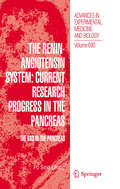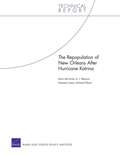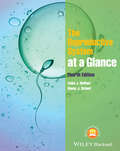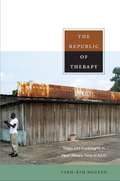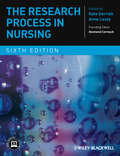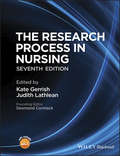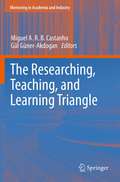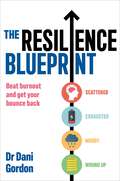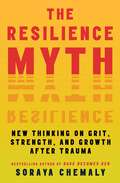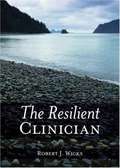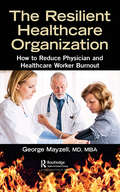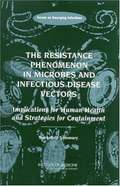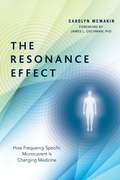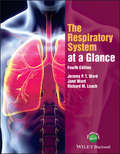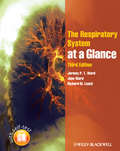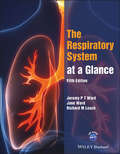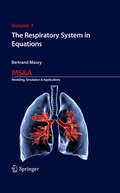- Table View
- List View
The Renin Angiotensin System in Cancer, Lung, Liver and Infectious Diseases (Advances in Biochemistry in Health and Disease #25)
by Naranjan S. Dhalla Paramjit S. Tappia Sukhwinder K. BhullarThis book of the series on “Advances in Biochemistry in Health and Disease” includes state-of-the-art information on the status of renin-angiotensin system (RAS) in the form of 24 chapters. This book has been organized into three sections: (i) General Implications of RAS in human health and Infectious Diseases, (ii) Lung, Liver and Kidney Diseases, and (iii) Development of Cancer. Each chapter has discussed comprehensive knowledge regarding the molecular and cellular aspects of the role of RAS in the pathophysiology and pharmacotherapy of different disease processes. Biochemical mechanisms associated with angiotensin II type 1 and type II receptors, and angiotensin (1-7) MAS receptors for the occurrence of both harmful and beneficial effects of prolonged activation of RAS in different diseases have been outlined. It is noteworthy to point out that different chapter in this book were prepared by recognized global expertise in the area of inflammation, oxidative stress and signal transduction pathways to highlight the role of RAS in different diseases. It is our sincere hope that this book will be of great interest to both biomedical investigators and health professionals as well as graduate students and postdoctoral fellows all over the world.
The Renin Angiotensin System in Cardiovascular Disease (Advances in Biochemistry in Health and Disease #24)
by Naranjan S. Dhalla Sukhwinder K. Bhullar Anureet K. ShahThis book on “Renin-Angiotensin System in Cardiovascular Disease” includes 25 chapters, which are organized in three sections, namely (i) modulatory aspects, (ii) pathophysiological aspects, and (iii) pharmacotherapeutic aspects. It includes an updated as well as comprehensive knowledge about molecular and cellular aspects for the role of the renin-angiotensin system (RAS) in the pathophysiology and therapy of cardiovascular diseases such as hypertension, atherosclerosis, ischemic heart disease, and heart failure. This book emphasizes the molecular and cellular mechanisms, signaling transduction pathways involved in the development of different cardiovascular diseases due to the prolonged activation of RAS. Furthermore, biochemical mechanisms are outlined for the inhibition of this system by the blockade of angiotensin converting enzyme as well as angiotensin II type 1 receptors in patients suffering from cardiovascular abnormalities. Since cardiovascular disease is the number one cause of death worldwide, leading to approximately 17.9 million deaths each year, there is a keen interest in understanding the pathogenesis and improving its therapy. In this regard, we can attest that this book provides ample information about essential components of RAS and their role in the development of cardiovascular disease.From the selection of recognized global experts in their area of investigation, this book can be seen to cover diverse cardiovascular aspects and molecular and cellular mechanisms of angiotensin II action for the development of different cardiovascular abnormalities. It is our contention that this book will be most suitable for promoting knowledge in the field of RAS biology and will be of great interest to health professionals involved in both experimental and clinical cardiology as well as academic investigators and cardiovascular scientists, graduate students, and fellows worldwide.
The Renin-Angiotensin System: Current Research Progress in The Pancreas
by Po Sing LeungThe human pancreas has vital roles in the regulation of glucose homeostasis and digestion and its dysfunction leads to pancreatic disease as diabetes and pancreatitis. Recent researches have highlighted the novel roles of a local renin-angiotensin system (RAS) in the pancreas and its clinical relevances; its inapprporiate activation leads to pancreatic endocrine and exocrine disease, notably type 2 diabetes. As such, manipulation of the overactive RAS may improve pancreatic islet cell function, cell mass and insulin sensitivity, as well as enhancing the growth and differentiation of pancreatic stem cells. Blockade of the RAS may be protective against pancreatitis and pancreatic cancer. The research outcome of current progress on the RAS in the pancreas should provide an alternative approach to preventing and treating, as well as curing pancreatic disease. This book discusses the progress of research on the renin-angiotensin system in the pancreas from the science to the bedside, providing a timely review of this expanding area. It consists of ten interrelated chapters covering subjects as: - Structure, physiology and disease of the pancreas - Biochemistry and physiology of the pancreatic renin-angiotensin system - RAS in diabetes, stem cells and pancreatitis This book is of special value to basic and clinical scientists, clinicians, graduate students, as well as novices in this field.
The Repopulation of New Orleans After Hurricane Katrina
by Kevin F. Mccarthy Michael Pollard D. J. Peterson Narayan SastryIn November 2005, New Orleans city leaders asked RAND to estimate the repopulation of the city in the aftermath of Hurricane Katrina. The Bring New Orleans Back Commission needed estimates of the city's population in the immediate and near-term future to guide the redevelopment planning process. An assessment of flood damage to housing based on the depth of floodwater and the likely pace of reconstruction of damaged housing guided the estimates.
The Reproduction of Inequality: How Class Shapes the Pregnant Body and Infant Health (Health, Society, and Inequality)
by Katherine MasonAn important analysis of the difference class makes in reproductive health choicesCan you run a marathon, drink coffee, eat fish, or fly on a plane while pregnant? Such questions are just the tip of the iceberg for how most pregnant women’s bodies are managed, surveilled, and scrutinized during pregnancy. The Reproduction of Inequality examines the intense social pressure that expectant and new mothers face when it comes to their health and body-care choices.Drawing on interviews with dozens of pregnant women and new mothers from poor, middle-class, and mixed-class backgrounds, Katherine Mason paints a vivid picture of the immense weight of expectation that comes with the early stages of motherhood. The women in Mason’s study universally sought to give their children a healthy start in life; however, their chosen approaches varied based on their socio-economic class. Whereas middle-class mothers attempted a complete lifestyle change and absolute devotion to the achievement and maintenance of “the healthy pregnant body,” poorer women made strategic choices about which health goals to prioritize on a limited budget, lacking the economic and cultural capital required to speak and perfectly adhere to the language of “good health.” The unfortunate result is that middle-class mothers are more likely to be seen by others and by themselves as “good” parents, whereas the efforts of working-class mothers are often misread as displaying inadequate concern about their health and that of their child. This in turn contributes to longstanding stereotypes about poor families and communities, and limits their children's chances for upward mobility. The Reproduction of Inequality is a compelling analysis of the impact of class on new mothers’ approaches to health and wellness, and a sobering examination of how inequality shapes mothers’ efforts to maximize their own health and that of their children.
The Reproductive System at a Glance
by Linda J. Heffner Danny J. SchustThe Reproductive System at a Glance is a comprehensive guide to normal reproductive biology and associated pathophysiology in both sexes. Concise, easy to read, and clearly structured, the double-page spreads progress from basic science to clinical abnormalities, and covers endocrine production and action, within one short volume. Chapters on disorders summarise epidemiology, pathophysiology, diagnosis and treatment.This new edition of The Reproductive System at a Glance:* Is fully revised and updated throughout to reflect recent developments in practice* Now features histological and pathological slides to complement the "at a glance" style explanatory illustrations* Now features radiologic studies to supplement the text in selected chapters* Contains more detailed coverage of maternal adaptations to pregnancy* Includes a companion website at www.ataglanceseries.com/reproduction featuring self-assessment multiple choice questions, bonus single answer questions and flashcardsThe Reproductive System at a Glance is an ideal guide for students studying both endocrine and reproductive subjects, and teaches the foundation concepts for the obstetrics and gynaecology rotation, helping health professionals and students achieve a broad and practical understanding of the topic.
The Republic of Therapy: Triage and Sovereignty in West Africa's Time of AIDS
by Vinh-Kim NguyenThe Republic of Therapy tells the story of the global response to the HIV epidemic from the perspective of community organizers, activists, and people living with HIV in West Africa. Drawing on his experiences as a physician and anthropologist in Burkina Faso and Cte d'Ivoire, Vinh-Kim Nguyen focuses on the period between 1994, when effective antiretroviral treatments for HIV were discovered, and 2000, when the global health community acknowledged a right to treatment, making the drugs more available. During the intervening years, when antiretrovirals were scarce in Africa, triage decisions were made determining who would receive lifesaving treatment. Nguyen explains how those decisions altered social relations in West Africa. In 1994, anxious to "break the silence" and "put a face to the epidemic," international agencies unwittingly created a market in which stories about being HIV positive could be bartered for access to limited medical resources. Being able to talk about oneself became a matter of life or death. Tracing the cultural and political logic of triage back to colonial classification systems, Nguyen shows how it persists in contemporary attempts to design, fund, and implement mass treatment programs in the developing world. He argues that as an enactment of decisions about who may live, triage constitutes a partial, mobile form of sovereignty: what might be called therapeutic sovereignty.
The Rescue Doc's Christmas Miracle
by Amalie BerlinFrom partners to parents! Dr. Gabriel Jackson and paramedic Penny Davenport make a great team-despite driving each other crazy! She's Manhattan Mercy's daredevil helicopter pilot, who thrives on adventure after a childhood spent wrapped in cotton wool, while he's the cautious flight doctor who, after a disastrous marriage, will never take risks again. But after the elation of surviving a storm explodes into passion, Penny discovers she's pregnant! This could be an unforgettable Christmas-if they listen to their hearts and take the greatest risk of all!
The Rescue Doctor's Baby Miracle
by Dianne DrakeA new life--a new hope... When Dr. Gideon Merrill finds out Dr. Lorna Preston is coming to film his search-and-rescue operation in a storm-devastated Brazilian village, everything he's tried to forget comes flooding back. Their passionate affair, their failed marriage--the baby they lost. Forced to work with her, he's soon struck by how different--how incredible--Lorna is. But a night of passion changes everything, and as they work miracles to save countless lives Gideon knows he and Lorna might just have made a tiny miracle of their own. Could a precious new life herald the start of an amazing new future--together?
The Research Process in Nursing
by Anne Lacey Kate Gerrish'The perfect text for any health care professional who wishes to gain a sound understanding of research...This text succeeds where others fail in terms of the thoroughness of the research process and the accessible style in which the material is presented. In an age when nursing and health care research is going from strength to strength this book offers those in the world of academia and practice an excellent and essential 'bible' that is a must on any bookshelf'Dr Aisha Holloway, Lecturer Adult Health, Division of Nursing, The University of Nottingham'a book that helps you each step of the way. A very understandable and enjoyable publication'Accident and Emergency Nursing Journal 'key reference resource that students of research can use at various levels of study. It is comprehensive, user friendly and very easy to read and make sense of'Gillian E Lang, Amazon reviewerThe sixth edition of this book reflects significant developments in nursing research in recent years, ensuring the reader is provided with the very latest information on research processes and methods. It continues to explore how to undertake research as well as evaluating and using research findings in clinical practice, in a way that is suitable for both novice researchers and those with more experience.Divided into six sections, the chapters are ordered in a logical fashion that also allows the reader to dip in and out. The first two sections of the book provide a comprehensive background to research in nursing. The third section presents a variety of qualitative and quantitative approaches, both new and well-established. The final three sections then look at collecting and making sense of the resulting data and putting the research findings into clinical practice.Summarises key points at the start of each chapter to guide you throughIncludes contributions from a wide range of experts in the fieldAccessible but doesn't shrink away from complex debates and technical issuesNew to this edition:Accompanying website (www.wiley.com/go/gerrish)Ten completely new chapters including Narrative Research, Mixed Methods and Using Research in Clinical Practice'Research Example' boxes from a wide variety of research types
The Research Process in Nursing
by Kate Gerrish Judith LathleanComprehensive and thorough in scope, The Research Process in Nursing 7th edition provides everything you could want to know about research methods. This established textbook reflects the significant advances in nursing research and the importance of evidence-based practice, and provides an invaluable resource for both the novice and the more experienced researcher. It includes practical information and advice on: How to find and critique the evidence How to choose the right approach How to collect data How to make sense of the data How to put research into practice Special features: A clear, explicit and easy to understand text which links theory with practical steps in the research process. Examples provided allow the reader to apply a variety of research concepts to theoretical learning and professional practice. Incorporates chapters, research examples, and policy from a range of international countries, including Canada, Australia, USA and Hong Kong. Provides detailed discussions around each example, which clearly link theory with practice Easy to read for novice researchers and undergraduate nursing students, but at the same time provides sufficient depth and detail to be of value to experienced researchers and practitioners.
The Researching, Teaching, and Learning Triangle
by Gul Guner Miguel A. CastanhoIt is impossible not to ask ourselves how to cope with the role and impact of scientific research in teaching and learning. The researching, teaching and learning triangle explores a growing trend among top universities across the world to focus attention on the quality of post-graduate education and the success of the educators, using pioneering examples, ranging from classroom-level initiatives to university-wide projects. This book will be of interest to all scientists, from the budding beginner to the seasoned supervisor.
The Resident's Guide to Shoulder and Elbow Surgery
by Anand M. Murthi Caroline M. ChebliUtilizing a practical, high-yield presentation, this textbook is a comprehensive review of the most common shoulder and elbow diagnoses and management strategies. It allows easy access to pertinent information for residents and fellows while preparing for rounds, the clinic and the operating room and also aides residents studying for their yearly in-training exam (OITE). Each topic is organized in a consistent, bulleted format so that the information flows in a logic manner: history, physical examination, imaging (when and what to order), and the most appropriate treatment algorithm. The most common classification systems are emphasized and illustrated, and treatment algorithms are further organized into non-operative and operative and include surgical approaches as well as the risks and complications of surgical intervention. The shoulder and elbow are covered in their own exclusive sections, with each chapter discussing the unique diagnostic considerations for each anatomic structure and the types of injuries to expect. Topics in the shoulder section include osteoarthritis, rotator cuff arthropathy and tears, instability, stiffness, SLAP tears and biceps tendinitis, and fractures of the clavicle and scapula. Topics in the elbow section include biceps and triceps rupture, lateral and medical epicondylitis, instability and stiffness, and elbow fractures - distal humerus, Monteggia, the terrible triad and more. Case material, key points and takeaways, and question-and-answer elements are included to enhance the text's overall utility. There is currently no textbook on the shoulder and elbow tailored specifically for orthopedic residents, fellows and senior medical students. The Resident's Guide to Shoulder and Elbow Surgery therefore provides a much-needed resource for early-career clinicians and surgeons.
The Resident's Guide to Spine Surgery
by Joseph R. O’Brien S. Bobby Kalantar Doniel Drazin Faheem A. SandhuWith an emphasis on set-up and execution and lessons learned from expert practitioners, this concise, practical guide for residents and fellows presents the essentials for both common and complex spine surgery. Proceeding anatomically from the cervical to the sacroiliac, and including chapters on spinal tumors, infection and revision surgery, nearly 40 different procedures are highlighted, from corpectomy, arthroplasty and laminectomy to percutaneous screws, decompression and fusion. Chapters include all the information a resident will need to know: indications and contraindications, imaging and diagnosis, OR set-up and instrumentation selection, the specific operative technique, post-operative protocols, and clinical pearls and pitfalls. Radiographs and full-color intraoperative photographs accompany each procedure. Whether suturing dura or performing a lateral interbody fusion, spinal surgery is a technical pursuit, and having a firm grasp of the details can ultimately determine the procedure's success. Written and edited by veterans in orthopedic surgery and neurosurgery, The Resident's Guide to Spine Surgery is just the detailed, user-friendly resource for up-and-coming clinicians looking to develop and expand their surgical expertise.
The Resilience Blueprint: Beat burnout and get your bounce back
by Dr Dani GordonYou're never too unhealthy, too tired or too late to become the most dynamic, energetic and resilient version of yourselfWe'd all like to be able to bounce back from life's inevitable setbacks, whether those are health issues or emotional challenges. And perhaps we're resilient in one area, such as never catching colds, but not in another, such as we're constantly feeling overwhelmed and anxious. That's because each of us has a resilience type, and if you're not aware of yours, all of your efforts to be healthy may be failing to make a difference. Even the most up to date health advice may not be right for you if it's wrong for your type.Find out if you're a highly strung WOUND-UP WARRIOR, an emotional MOODY WARRIOR, a drained EXHAUSTED WARRIOR, or an easily distracted SCATTERED WARRIOR. Integrative functional medicine doctor Dani Gordon will guide you to identify your personal resilience type, and then offer all the scientifically backed health advice you need to put her transformative 8-week resilience programme into action.This empowering and compassionate guide gives you not just the tools, but the confidence to change your life.
The Resilience Myth: New Thinking on Grit, Strength, and Growth After Trauma
by Soraya ChemalyThe author of the &“must-read&” (NPR) Rage Becomes Her presents a powerful manifesto for communal resilience based on in-depth investigations into history, social science, and psychology.We are often urged to rely only on ourselves for strength, mental fortitude, and positivity. But with her distinctive &“skill, wit, and sharp insight&” (Laura Bates, author of Girl Up), Soraya Chemaly challenges us to adapt our thinking about how we survive in a world of sustained, overlapping crises. It is interdependence and nurturing relationships that truly sustain us, she argues. Based on comprehensive research and eye-opening examples from real-life, The Resilience Myth offers alternative visions of relational hardiness by emphasizing care for others and our environments above all.
The Resilient Clinician
by Robert J. WicksThis immensely readable book also includes one of the most current selective bibliographies of relevant research and clinical and theoretical publications in the subject area, from common stressors and vicarious post-traumatic stress disorders to burnout and compassion fatigue.
The Resilient Healthcare Organization: How to Reduce Physician and Healthcare Worker Burnout
by George Mayzell, MD, MBAProfessional burnout is an epidemic in America. Approximately half of physicians and nurses are affected and at risk for themselves and their patients. Much has been written about professional burnout. The term was originally coined in the 1970s by American psychologist Herbert Freudenberger to describe the consequences of severe stress and high ideals experienced by people working in "helping" professions. Since then, many books have been written to address this looming national public health crisis. But, unfortunately, there has been much less written from a solution standpoint: getting to the root cause of why this is occurring now more than ever. The Resilient Healthcare Organization engages readers focusing on physicians and healthcare professionals and their experiences and how they overcame a loss of enthusiasm for work, feelings of cynicism, and a low sense of personal accomplishment. The feelings of emotional exhaustion are characterized by depersonalization and perceived ineffectiveness. These are the cardinal features that define "burnout" and affect almost 50% of physicians and 30–70% of nurses. This book addresses why burnout is viewed as a threat and how it can be fought. The author discusses the contributing factors and solutions at the health system and societal level. Additionally, this book explores the current and future etiology and impacts on physicians and healthcare professionals, with a significant emphasis on solutions at both the individual level and the system level. Contributors: Patricia S. Normand MD, Bruce Flareau, MD, Kathleen Ferket, MSN, APRN, Daniel Edelman, DO, and Peter B. Angood, MD.
The Resistance Phenomenon in Microbes and Infectious Disease Vectors: Implications for Human Health and Strategies for Containment
by Forum on Emerging InfectionsThe resistance topic is timely given current events. The emergence of mysterious new diseases, such as SARS, and the looming threat of bioterrorist attacks remind us of how vulnerable we can be to infectious agents. With advances in medical technologies, we have tamed many former microbial foes, yet with few new antimicrobial agents and vaccines in the pipeline, and rapidly increasing drug resistance among infectious microbes, we teeter on the brink of loosing the upperhand in our ongoing struggle against these foes, old and new. "The Resistance Phenomenon in Microbes and Infectious Disease Vectors examines our understanding of the relationships among microbes, disease vectors, and human hosts, and explores possible new strategies for meeting the challenge of resistance.
The Resonance Effect: How Frequency Specific Microcurrent Is Changing Medicine
by Carolyn Mcmakin James L. OschmanThe Resonance Effect is both the author's story of her inspirational journey of having the courage to find her true calling and an account of the development of a remarkable newly rediscovered treatment, frequency specific microcurrent (FSM), that takes advantage of the body's ability to respond to frequencies in order to heal a number of chronic conditions. Carolyn McMakin, a chiropractor specializing in fibromyalgia and myofascial pain, describes her experience using a two-channel microcurrent device that has achieved astounding results that have changed medicine and created new possibilities for suffering patients over the past twenty years. Nerve pain, fibromyalgia, diabetic neuropathies, muscle pain, athletic performance, injury repair, joint pain, low back pain, neck pain, kidney stone pain, the kidney stones themselves, liver disease, diabetic wounds, brain and spinal cord injuries, PTSD, depression, shingles, asthma, ovarian cysts, abdominal adhesions, and scarring all respond to specific frequencies. McMakin explains that results are predictable, reproducible, and teachable—all without side effects—offering hope and healing to millions of people.McMakin tells the story of how thousands of patients with conditions that did not respond to other medical therapies recovered from pain and disability through the non-invasive treatment that she developed. For example, asthma resolves with specific frequencies that remove inflammation, allergy reaction, and spasm from the bronchi. One frequency combination eliminates shingles pain in minutes and stops the shingles attack with a single three-hour treatment. Since 2005, a series of frequencies has been used to treat hundreds of PTSD patients. Post-surgical patients use FSM to reduce pain, prevent bruising, and increase healing. NFL, NHL, and Olympic athletes use it to heal injuries and improve performance. McMakin includes case histories that illustrate the efficacy of the treatment and shares the specific frequencies that each condition requires so that patients direct their own treatments.
The Respiratory System (Peate's Body Systems)
by Ian PeatePEATE’S BODY SYSTEMS THE RESPIRATORY SYSTEM A CONCISE, ILLUSTRATED, AND ACCESSIBLE GUIDE TO THE RESPIRATORY SYSTEM Each of the twelve volumes in Peate’s Body Systems series is rooted in the belief that a deep and thorough understanding of the human body is essential for providing the highest standard of care. Offering clear, accessible and up-to-date information on different body systems, this series bridges the gap between complex scientific concepts and practical, everyday applications in health and care settings. This series makes for an invaluable resource for those committed to understanding the intricacies of human biology, physiology and the various systems that sustain life. The Respiratory System is the perfect companion for students and newly registered practitioners across nursing and allied health fields with an interest in respiratory care, providing a comprehensive yet easy-to-digest guide for both academic and clinical application. Equips healthcare students and practitioners with the necessary information to provide safe and competent careFeatures colourful illustrations to aid comprehension, clarify complicated concepts, and render content more engaging and accessibleEmpowers readers to adapt to a rapidly evolving healthcare landscape, preparing them for the future of healthcare deliveryContains information necessary for effective patient care of those with Chronic Obstructive Pulmonary Disease (COPD), asthma, lung cancer and other respiratory diseases and conditions
The Respiratory System at a Glance
by Jeremy P. Ward Jane Ward Richard M. LeachFollowing the familiar, easy to use at a Glance format, and now in full-colour, The Respiratory System at a Glance is an accessible introduction and revision text for medical students.<P><P> Reflecting changes to the content and assessment methods used in medical education and published clinical recommendations, this at a Glance provides a user-friendly overview of the respiratory system to encapsulate all that the student needs to know. This new edition of The Respiratory System at a Glance: Integrates both basic and clinical science - ideal for systems-based courses Includes both the pathophysiology and clinical aspects of the respiratory system Features more case studies, updated and colour figures, and new chapters on the epidemiology of respiratory disease, public health issues, and Sarcoidosis Includes self-assessment questions and answers and an appendix of tables of standard values Provides a simple 'one-stop' easy to use course and revision text
The Respiratory System at a Glance (At a Glance #41)
by Jeremy P. Ward Jane Ward Richard M. LeachFollowing the familiar, easy to use at a Glance format, and now in full-colour, The Respiratory System at a Glance is an accessible introduction and revision text for medical students. Reflecting changes to the content and assessment methods used in medical education and published clinical recommendations, this at a Glance provides a user-friendly overview of the respiratory system to encapsulate all that the student needs to know. This new edition of The Respiratory System at a Glance: Integrates both basic and clinical science - ideal for systems-based courses Includes both the pathophysiology and clinical aspects of the respiratory system Features more case studies, updated and colour figures, and new chapters on the epidemiology of respiratory disease, public health issues, and Sarcoidosis Includes self-assessment questions and answers and an appendix of tables of standard values Provides a simple 'one-stop' easy to use course and revision text
The Respiratory System at a Glance (At a Glance)
by Jeremy P. Ward Jane Ward Richard M. LeachThe Respiratory System at a Glance The market-leading at a Glance series is popular among healthcare students and newly qualified practitioners for its concise, simple approach and excellent illustrations. Each bite-sized chapter is covered in a double-page spread with clear, easy-to-follow diagrams, supported by succinct explanatory text. Covering a wide range of topics, books in the at a Glance series are ideal as introductory texts for teaching, learning and revision, and are useful throughout university and beyond. Everything you need to know about The Respiratory System… at a Glance! Highly-illustrated overview of the structure and function of the lungs and airways, with sections on history, examination, pathophysiology, treatment and management Respiratory System at a Glance is a comprehensive guide to normal lung structure and function and associated pathophysiology, featuring key information on all major respiratory disorders. As per the familiar, easy-to-use ‘at a Glance’ format, each topic is presented as a double-page spread, with key facts accompanied by clear diagrams that encapsulate essential knowledge. This ‘one-stop’ resource has been revised and updated for this 5thedition to include recent advances in our understanding and/or treatment of asthma, COPD, pulmonary vasculitis, sarcoidosis, cystic fibrosis, respiratory infections (including COVID-19), and the most recent national clinical management guidelines. The accompanying website includes self-assessment case studies, flashcards and MCQs to support learning or for review. Respiratory System at a Glance also provides information on: Structure and function of the respiratory system, the thoracic cage and respiratory muscles, gas laws, diffusion, and elastic forces Acid-base balance and disorders, control of breathing through chemical and neural mechanisms, and pulmonary circulation and ventilation-perfusion matching Exercise, altitude, and diving, complications of development and congenital disease, lung defense mechanisms, and immunology of the lungs Public health and smoking, respiratory failure, and the pathophysiology and management of asthma, chronic obstructive pulmonary disease and other respiratory disorders With accompanying self-assessment clinical cases and multiple-choice questions, The Respiratory System at a Glance is the ideal companion for anyone about to start a respiratory module or rotation, and will appeal to medical students and junior doctors, as well as nurses, dentists, physiotherapists, technicians, and biomedical scientists. For more information on the complete range of Wiley nursing and health publishing, please visit: www.wiley.com To receive automatic updates on Wiley books and journals, join our email list. Sign up today at www.wiley.com/email All content reviewed by students for students Wiley Medical Education books are designed exactly for their intended audience. All of our books are developed in collaboration with students. This means that our books are always published with you, the student, in mind. If you would like to be one of our student reviewers, go to www.reviewmedicalbooks.com to find out more. This new edition is also available as an e-book. For more details, please see www.wiley.com
The Respiratory System in Equations
by Bertrand MauryThis book proposes an introduction to the mathematical modeling of the respiratory system. A detailed introduction on the physiological aspects makes it accessible to a large audience without any prior knowledge on the lung. Different levels of description are proposed, from the lumped models with a small number of parameters (Ordinary Differential Equations), up to infinite dimensional models based on Partial Differential Equations. Besides these two types of differential equations, two chapters are dedicated to resistive networks, and to the way they can be used to investigate the dependence of the resistance of the lung upon geometrical characteristics. The theoretical analysis of the various models is provided, together with state-of-the-art techniques to compute approximate solutions, allowing comparisons with experimental measurements. The book contains several exercises, most of which are accessible to advanced undergraduate students.


